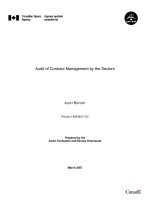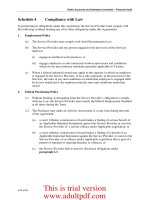Essentials of accounts payable by mary s schaeffer
Bạn đang xem bản rút gọn của tài liệu. Xem và tải ngay bản đầy đủ của tài liệu tại đây (2.5 MB, 287 trang )
AM
FL
Y
ESSENTIALS
TE
of Accounts Payable
Team-Fly®
Essentials Series
The Essentials Series was created for busy business advisory and corporate professionals.The books in this series were designed so that these
busy professionals can quickly acquire knowledge and skills in core
business areas.
Each book provides need-to-have fundamentals for those professionals who must
Get up to speed quickly, because they have been
promoted to a new position or have broadened their
responsibility scope
•
• Manage a new functional area
• Brush up on new developments in their area of
responsibility
• Add more value to their company or clients
Other books in this series include the following:
Essentials of Capacity Management,
by Reginald Tomas Yu-Lee
Essentials of Corporate Performance Management,
by Franklin Plewa and George Friedlob
Essentials of CRM: A Guide to Customer
Relationship Management,
by Bryan P. Bergeron
For more information on any of these titles, please visit
www.wiley.com.
ESSENTIALS
of Accounts Payable
Mary S. Schaeffer
Editor of
IOMA’s Report on Managing Accounts Payable
Copyright © 2002 by John Wiley & Sons, Inc. All rights reserved.
Published by John Wiley & Sons, Inc., New York.
No part of this publication may be reproduced, stored in a retrieval system or
transmitted in any form or by any means, electronic, mechanical, photocopying,
recording, scanning or otherwise, except as permitted under Sections 107 or
108 of the 1976 United States Copyright Act, without either the prior written
permission of the Publisher, or authorization through payment of the appropriate
per-copy fee to the Copyright Clearance Center, 222 Rosewood Drive, Danvers,
MA 01923, (978) 750-8400, fax (978) 750-4744. Requests to the Publisher for
permission should be addressed to the Permissions Department, John Wiley &
Sons, Inc., 605 Third Avenue, New York, NY 10158-0012, (212) 850-6011, fax
(212) 850-6008, E-Mail:
This publication is designed to provide accurate and authoritative information
in regard to the subject matter covered. It is sold with the understanding that the
publisher is not engaged in rendering legal, accounting, or other professional
services. If legal advice or other expert assistance is required, the services of a
competent professional person should be sought.
This title is also available in print as ISBN 0-471-20308-4. Some content that
appears in the print version of this book may not be available in this electronic
edition.
For more information about Wiley products, visit our web site at
www.Wiley.com
for my wonderful, talented son
Benedict Ronald Ludwig
Preface
common misconception about accounts payable is that it is not
very complicated or sophisticated.“What’s the big deal?” the skeptics ask.“The accounts payable department just pays bills.” Anyone
who knows anything at all about accounts payable knows that it is a big
deal. When the accounts payable function is not handled correctly,
duplicate payments abound, check fraud thrives, costs skyrocket, discounts are lost, vendor relations falter, and certain state regulatory agencies
may arrive more frequently to perform an audit (unclaimed property
and/or sales and use tax). And that is just the tip of the iceberg.
Unfortunately, some accounts payable associates have done a poor
job in educating their bosses about the complexities of the accounts
payable functions and responsibilities, and the business and financial
press has virtually ignored their contributions, as well. The purpose of
this book is not only to change those perceptions, but also to provide a
solid foundation for those just starting out in accounts payable. Because
we’ve included some brand new areas, including Extensible Markup
Language (XML), the Internet, imaging, and more, more seasoned
accounts payable professionals will benefit from the book as well.
The book begins with a quick review of the accounting and bookkeeping functions as they relate to accounts payable. It also shows how
accounts payable information fits into the big picture and provides
some of the foundation information for the company’s financial reports.
Because virtually all accounts payable departments pay bills, the
chapter on invoice handling is quite thorough in explaining how
A
vii
Preface
corporate America handles its invoices and writes its checks. These
once-routine chores have now become quite complicated, and if they
are not handled correctly, problems will abound. Best practices in both
areas are discussed.
Despite accounts payable associates’ best efforts, inevitably some
invoices need to be processed outside the normal time frame. Exception
handling and the Rush check issues are examined in detail. Although it
is not possible to completely eliminate Rush checks (Wouldn’t that be
wonderful!) there are ways to limit the numbers of these annoying
items and also limit the problems they create.
Third-party audit firms continue to thrive, collecting duplicate and
other types of erroneous payments made by companies everywhere. If
duplicate payments were prevented before they occurred, companies
would not support this thriving business. The chapter on preventing
duplicate payments recommends the best ways to do this. In fact, it contains tips from several well-regarded professionals who make a rather
attractive living chasing the duplicate payments made by companies of
all sizes.
One of the biggest causes of duplicate payments are payments made
when the original invoice cannot be found. Although refusing to pay is
not a reasonable approach—after all, mail does get lost—there are ways
to pay from a copy without greatly increasing the odds of making a
duplicate payment. Chapter 6 looks at the best ways to pay a lost or
missing invoice without creating additional problems, that is, making a
duplicate payment.
The purchasing–accounts payable relationships in many companies
leaves much to be desired.These two departments often do not get along.
This is unfortunate because they both benefit from smoother relations.
Chapter 7 suggests ways that the accounts payable associate can make this
tenuous relationship work even under the most trying of circumstances.
viii
Preface
Few companies give their master vendor file the attention or care
it deserves. We take a look at the statistics regarding how corporate
America treats its master vendor files, the problems that can arise from
inadequate care and controls, and ways that companies can best maintain their master vendor file.
Early-payment discounts are near and dear to the hearts of many
corporate controllers. It falls on the accounts payable department to
ensure that all the discounts are taken. In fact, one accounts payable professional says the only way to get the controller at his company angry is
to lose one of these discounts. Chapter 9 explains how these discounts
work, why they are so important, and who takes them and under what
circumstances. It also examines the deduction issue and the effects of
taking unauthorized discounts. This chapter suggests how to work best
with suppliers when taking discounts and lists deductions that might be
unfamiliar.
Handling travel and entertainment (T & E) expense reports typically
falls under the accounts payable umbrella. For many, it is a thankless
function that is time consuming and adds little value. Chapter 10 evaluates current processes and recommends ways to make the traditional
function operate just a little smoother.
T & E is one of the areas in accounts payable that is experiencing
much change. As hotels look for ways to increase income, they have
developed some unique ways to increase revenue without appearing to be
raising their prices. They are identified so accounts payable associates will
be aware of them when they encounter them. Similarly, phone charges
have gotten out of hand, and there are ways to fight these excess fees.
Finally, the chapter on T & E in the twenty-first century takes a look
at the phenomenon of cell phones and how these instruments are changing the corporate landscape. It also reviews current cell-phone policies
and discusses how companies are paying for this new device.
ix
Preface
Electronic Data Interchange (EDI) had been around since the late
1970s. Although current projections for future growth are no longer off
the charts (thanks to the Internet and XML), most experts believe that
this stodgy electronic methodology will be with us for years to come.
Thus, most accounts payable associates will need to have some basic
understanding of EDI and its impact and use in accounts payable.
Chapter 12 addresses these and other related EDI topics.
The Internet has invaded accounts payable departments everywhere,
radically changing the way many perform their day-to-day functions.
Chapter 13 takes a look at how companies are using the Internet in
accounts payable. It also contains many Web site addresses that illustrate
many of the points.
XML is revolutionizing the way companies report and share data.
Chapter 14 provides accounts payable associates with the basic XML
information they need to understand the process and its impact on
accounts payable. This is an area that will grow rapidly in the next few
years, and it is important that accounts payable associates get in on the
ground floor.
P-cards, also referred to as corporate procurement cards, have made
a major impact on accounts payable, drastically reducing the number of
invoices for companies that make effective use of these cards. Chapter
15 reviews some of the basic data related to p-cards and shares some
advice for getting the most out of them. It also evaluates the types of
data currently available for general ledger updates.
Fraud, especially check fraud, is a growing problem in corporate
America. Companies that do not understand the dynamics and learn how
to protect themselves will find themselves victims of the unscrupulous.
Chapter 16 reviews some of the more common types of accounts payable
fraud and offers suggestions for companies that wish to protect themselves against hucksters looking to take their money.
x
Preface
TE
AM
FL
Y
A number of new technologies, including imaging, interactive voice
response units, encryption, and digital signatures are being used very
effectively in accounts payable departments. Chapter 17 discusses these
technologies and presents a number of case studies that demonstrate
how real-life companies have integrated these approaches into their
accounts payable departments.
Sales and use tax, escheat, evaluated receipt settlement, benchmarking, audit firms, value-added tax (VAT) recapture, and 1099s are just a
few of the other issues handled in a growing number of accounts
payable departments across the country. These and other high-level
accounts payable concepts are explained in Chapter 18.
Eventually, after working in accounts payable for a number of years,
most accounts payable professionals will be given the opportunity to
manage a group, first perhaps as a supervisor and then eventually as the
manager of the department. Chapter 19 provides an overview of the
skills and requirements for that challenging position.
Accounts payable is changing rapidly. The skills and education
needed to survive in the past simply won’t cut the mustard. Chapter 20
takes a look at the brave new accounts payable world in the twenty-first
century and tells our readers what to expect and what they need to do
to prepare to be an accounts payable survivor in the next decade.
Good luck—it will be a challenging, yet exciting time.
xi
Team-Fly®
Acknowledgments
hroughout this book you will see mention of a company called
IOMA (Institute of Management and Administration), a New
York City–based newsletter publisher. It is the company I work for
and is the publisher of, among many others, a monthly newsletter called
IOMA’s Report on Managing Accounts Payable. In my position as editor of
this publication since 1995, I have had the opportunity to interact with
hundreds of accounts payable professionals and the vendors who provide accounts payable services. It is from these interactions that I am
able to develop new material—not only for the newsletter each month,
but also for this book.
When we started the newsletter, there was very little published on
the topic. IOMA stepped in to fill this void and today those who want
information can find it, not only in the newsletter but also in our
books, on the Internet, and at conferences. IOMA also produces valuable research for the accounts payable profession. Throughout this
book, you will find a smattering of benchmarking statistics. These come
from a biannual survey of more than 900 responses from the accounts
payable community. They provide a snapshot view of what is being done
in today’s accounts payable departments in companies of all sizes and in
all industries. They are presented to guide the reader toward current best
practices.
Without the backing from IOMA in the accounts payable research,
neither the newsletter nor the books nor the valuable benchmarking
information would be possible.
T
xiii
Contents
1
Some Accounting and Bookkeeping Basics
2
Invoice Handling: The Three-Way Match and More
11
3
Checks: The Traditional Payment Mechanism
29
4
Exception Handling and Those Dreaded Rush Checks
47
5
Preventing Duplicate Payments and Other
Common Errors
57
Paying Lost or Missing Invoices without Creating
Additional Problems
73
7
Improving the Relationship with Purchasing
83
8
Master Vendor Files: An Often-Overlooked Function
95
9
Discounts, Deductions, and the Problems They Cause
107
10
Travel and Entertainment: The Traditional Functions
117
11
Travel and Entertainment in the Twenty-First Century
131
12
Electronic Data Interchange: The Key to a Paperless
Accounts Payable World
147
13
Using the Internet in Accounts Payable
157
14
Extensible Markup Language: What Accounts Payable
Pros Need to Know
169
Procurement Cards and Their Impact on the
Accounts Payable Function
179
6
15
xv
1
Contents
16
Fraud: Vendor, Employee, and Check
195
17
How Companies Are Using Technology in
Accounts Payable
207
18
High-Level Accounts Payable Concepts
225
19
Managing Your First Accounts Payable Department
241
20
Accounts Payable in the Twenty-First Century
251
Additional Resources
261
Index
263
xvi
CHAPTER 1
Some Accounting and
Bookkeeping Basics
After reading this chapter you will be able to
• Understand accounting and bookkeeping as they affect
accounts payable and where accounts payable fits into the
big financial picture
• Recommend good internal controls for accounts payable
policies and procedures
• Avoid common accounting mistakes
• Use common accounting and bookkeeping terminology
when discussing accounts payable related issues
n order to fully understand why matters are handled the way they are
in accounts payable, it is a good idea to know a little about accounting and bookkeeping. Much of what is done in the department has
strong accounting implications. By understanding basic accounting and
bookkeeping as they relate to accounts payable, associates will instinctively understand the reasoning behind certain actions. They will also be
able to avoid common mistakes that arise from a lack of understanding of
the difference between debits and credits. Remember, accounts payable
is a lot more than just paying bills.
I
1
ESSENTIALS of Accounts Payable
What Is Bookkeeping?
Bookkeeping is the first step—the recording of all activities and transactions. It is the first step in the accounting cycle. In fact, some of the
processes that are commonly referred to as accounting are actually
bookkeeping. For example, balancing a checking account statement is
actually a bookkeeping function, although it usually falls under the
accounting umbrella. Many consider gathering backup information,
such as is done in the three-way match, a bookkeeping function rather
than an accounting function.
What Is Accounts Payable?
The accounts payable figure on the financial statements of any company
represents the company’s unpaid bills. It is the money owed by the company to its suppliers and other creditors. Accountants break the money
owed by the company into two groups: current liabilities and long-term
liabilities. They consider accounts payable a current liability. Current liabilities are those obligations that must be paid in less than one year. Other
current liabilities might include taxes and salaries. These are separated from
items such as long-term debt repayments that have longer due dates.
I s It Bookkeeping or Is It Accounting?
Don’t waste a lot of time trying to determine whether something is an
accounting function or a bookkeeping function—it doesn’t really matter
what you call it. To use an old Shakespearean quote, “A rose by any
other name smells just as sweet. . . .” As long as the function is performed correctly, its classification really doesn’t matter.
L iabilities
A company’s liabilities are its obligations. They include items such as
bank loans, money owed to vendors (also known as accounts payable),
2
Some Accounting and Bookkeeping Basics
employees’ salary, and any other expenses that might arise from the
business operations. Typically, liabilities are broken into two categories:
short term and long term. Short-term liabilities are typically those that
must be paid in the next 12 months while long-term liabilities are those
that are due after 12 months.
Thus, accounts payable is almost always a short-term liability. Interest
on bank loans is typically considered short term while the principal
repayment is classified as long term—until the year they become due.
A ssets
The opposite of a company’s liabilities are its assets. One hopes to work for
a company whose assets exceed its liabilities. For accounting purposes,
the company’s assets are everything it owns. These, too, are broken down
into two groups: current and fixed. Current assets are items that can be
converted to cash rather easily. They include accounts receivable, inventory, and prepaid rent.
Fixed assets are items that are generally not held for resale purposes.
This includes items like machinery, real estate, and furniture. Although
it is true that most of these items could be turned into cash, this could
not be done easily, so they are not considered current or liquid assets.
When analysts look at assets and liabilities, they not only study the
relationship between the two, but also look closely at the comparison
between current assets and current liabilities. If current liabilities exceed
current assets, there can be serious financial consequences.
E xpenses
Expenses can be classified several ways:
Pre-paid expenses are monies paid in advance for a product or
service. They are actually considered an asset until the expense
is incurred. The most common pre-paid expense is insurance,
which can sometimes be paid as infrequently as annually.
•
3
ESSENTIALS of Accounts Payable
• Current expenses are expenses that have been incurred (and
thus are considered a liability) and will be paid within the
current period.
• Accrued expenses are expenses that a company has incurred but
has not been billed for yet. Many companies accrue accounts
payable expenses at the end of each month and virtually all
accrue them at the end of the fiscal year for financial statement purposes. It is not uncommon to hear accounts payable
associates talking about doing accruals at month end.
Using accruals allows the company’s executives and bankers and—
in the case of public companies, its investors—to have a realistic picture
of the company’s financial position and obligations. These numbers can
be especially meaningful in the case of those companies that employ
payment timing or stretching practices.
A ccruals
Accounts payable associates will sometimes indicate that they are doing
accruals. As just indicated, this is usually done at the end of some sort of
a reporting period. Typically, what the associate is doing is calculating
the expenses that have been incurred but for which no invoice has been
received. This is not done in every accounts payable department but is
performed in many.
C har t of Accounts
When accounts payable associates record information, they must have a
category with which to associate the information. To do this, most companies assign a reference number or an account number. The list of all
these account numbers is called the chart of accounts. It is sometimes
referred to as the index of the general ledger. Each company develops
its own chart of accounts. The number of accounts is limited only by
4
Some Accounting and Bookkeeping Basics
the imagination of the company’s accountant and the company’s detail
requirements. There can be as few as 50 accounts for a small company,
or many more. A few nimble accounts payable associates end up knowing the account codes of their most common transactions by heart and
rarely refer to the chart of accounts.
General Ledger
TE
AM
FL
Y
The entire chart of accounts for a particular company and all its related information is called the general ledger. It is referred to in accounting literature as the GL, sometimes written G/L. It is the information
pertaining to the actual accounts, and great care is given to who has
access to it and who can update information in it. In fact, there is often
great debate about outside information being fed directly into the G/L.
Some auditors recommend against this unless strong controls monitor
the outside input. Others prefer these updates be done to some sort of
a suspense account, with the company doing the update after the outside information has been reviewed.
Debit and Credit Memos
This area sometimes leads to confusion in accounts payable—the results
of which can be pretty strange. A debit memo is a convenient way of letting a creditor know that the company wants to debit the vendor’s
accounts payable account for a return, a price reduction, or some other
matter. In an ideal situation, the creditor will confirm this reduction by
issuing a credit memo. As you might have guessed by now, reality is not
always so smooth. Sometimes, the supplier will realize it was overpaid
and issue a credit memo—which it doesn’t give to the customer. The
credit balance sits on the account. Eventually, the vendor may simply
write off the amount, never giving it to the customer.
5
Team-Fly®
ESSENTIALS of Accounts Payable
IN
THE
REAL WORLD
How General Ledger
Information Is Used
In addition to special company management reports that are produced from the G/L, most companies produce three very important
types of reports that are used by lenders, outside investors, and
others considering lending money to a corporation.
Balance sheet—The balance sheet, also referred to as the
statement of condition or the statement of financial position,
shows the status of the company’s assets, liabilities, and
owner’s equity at a given point in time. Balance sheets are
sometimes unofficially called a snapshot view of a company’s
financial health. Like a snapshot, the view can change seconds after it is taken.
Income statement—The income statement, also referred to
as the profit and loss statement (P & L), summarizes the revenues, costs, and expenses during a given period.
Statement of cash flow—This report summarizes the organization’s cash inflows and outflows for a given period.
Taken together, the balance sheet and income statement make up
a company’s financial statement. Thus, when a firm is asked to provide its financial statement, it must supply its balance sheet and
income statement. Traditionally, the financial statements had been
the main tools used to analyze a company’s financial performance.
However, given some of the gimmicks and one time or extraordinary
gains (or losses) that companies sometimes post on financial statements, a number of analysts now also focus on the statement of
cash flow.
6
Some Accounting and Bookkeeping Basics
In the worse-case scenario, the vendor does send the credit memo
to the customer and the accounts payable associate, not understanding
debit and credit memos, pays the credit memo. Now the company
has double paid the vendor an amount it never owed in the first place.
This, unfortunately, is not an uncommon occurrence, and is one of the
reasons accounts payable associates need to understand rudimentary
accounting.
Sometimes you will see debits abbreviated as dr. and credits as cr.
The abbreviations come from the Latin terms from which the terms are
derived, debere and credere.
A djusting Entries
When the books are closed, usually at the end of the month, often times
adjusting entries will be made. These are generally for items that cannot be recorded in the daily transactions. Many companies close their
books several days before the end of an accounting period so they can
get all the necessary work completed by the end of the period (usually
a month). Additionally, at year-end the books may be kept open to the
last possible moment in an attempt to get in every last item.
GAAP
Companies are under great pressure to produce the best possible numbers
in their financial statements. If there were no guiding principles, some
might be tempted to fudge the numbers. To make sure their statements
meet regulators standards, companies must complete their accounting
using generally accepted accounting principles (GAAP) standards. This
also makes it possible to compare financial reports from one company
with those from another. Expect to hear about financial statements prepared using GAAP or according to GAAP guidelines.
7
ESSENTIALS of Accounts Payable
The goal of GAAP is to prevent companies from using a variety of
creative accounting techniques to make the numbers look better than
the company actually does.
Year-End Window Dressing
Companies that rely heavily on their year-end financial statements will
sometimes take great pains to make sure the numbers make the company look as good as possible. There is absolutely nothing wrong with
this as long as the year-end manipulations are done according to GAAP.
For example, a company that normally stretches its payments may
decide to pay within terms to avoid showing a large accounts payable
balance. Some might view an unusually large accounts payable figure
with a skeptical eye, thinking it indicates a problem. Conversely, other
companies might decide to stretch payments longer at the end of a fiscal period to show a large cash balance in that period.
A udit Trails
Accountants are famous for talking about audit trails—and with good
reason. They make a lot of sense.Whenever possible, make it very clear
why and how certain actions were taken. For example, if an invoice is
to be short paid, indicate the reason in the file. To make the issue even
clearer, some companies pay the entire original invoice and then issue
a debit memo to cover the difference. The exact methodology is less
important than making the reasoning clear to anyone who comes
along. Putting a note in your files might work for the accounts payable
department, but if that information is not available to others who might
need it, your audit trail might not be very clear.
Suspense Accounts
Sometimes it is not clear to what account an item should be booked.
Rather than delay the processing of the item, it is booked to a suspense
8
Some Accounting and Bookkeeping Basics
account to be researched further at a later date. The theory behind suspense accounts is that they allow the work to proceed and are to be
cleaned out shortly when the proper accounting is determined. However,
researching items in a suspense account is not at the top of anyone’s list,
so items often stay in suspense much longer than the company’s accountants and controllers would like. Left up to their own devices, many professionals would not use suspense accounts. However, they are a necessary
evil if one wants to run an efficient accounts payable department.
Summary
From this very brief review, accounts payable associates can see how
very important it is that the company’s accounts payable functions are
performed and recorded accurately. If not, the company’s financial statements will not be accurate and investors and potential lenders could be
misled.
9









